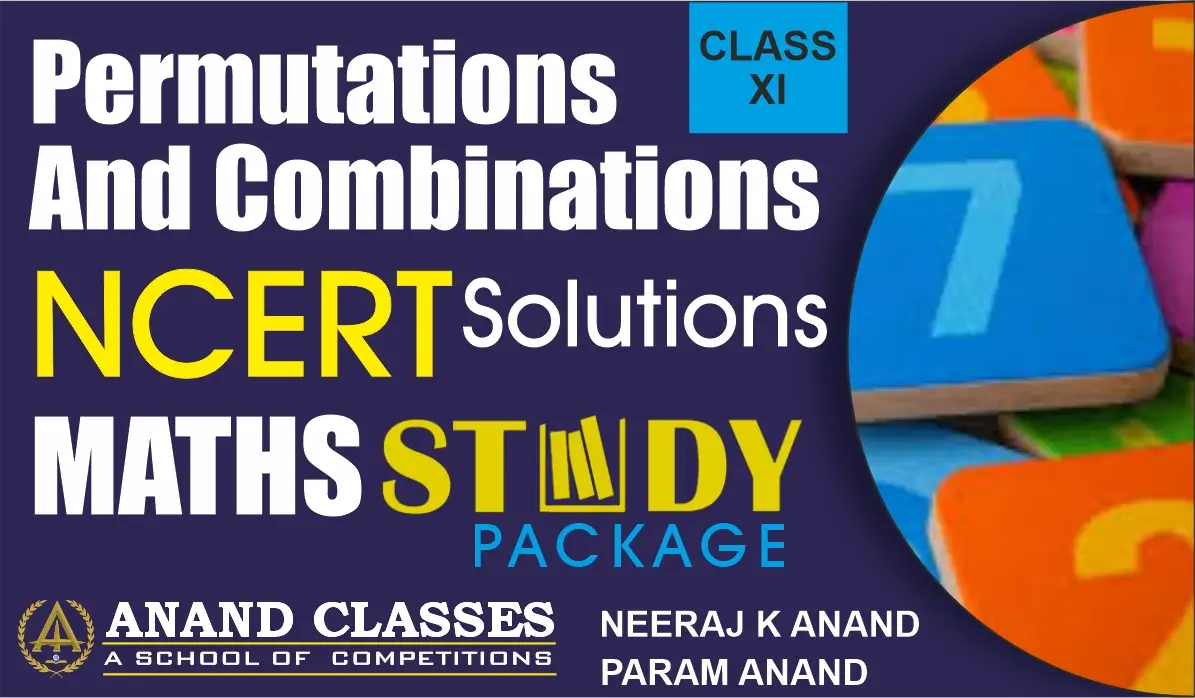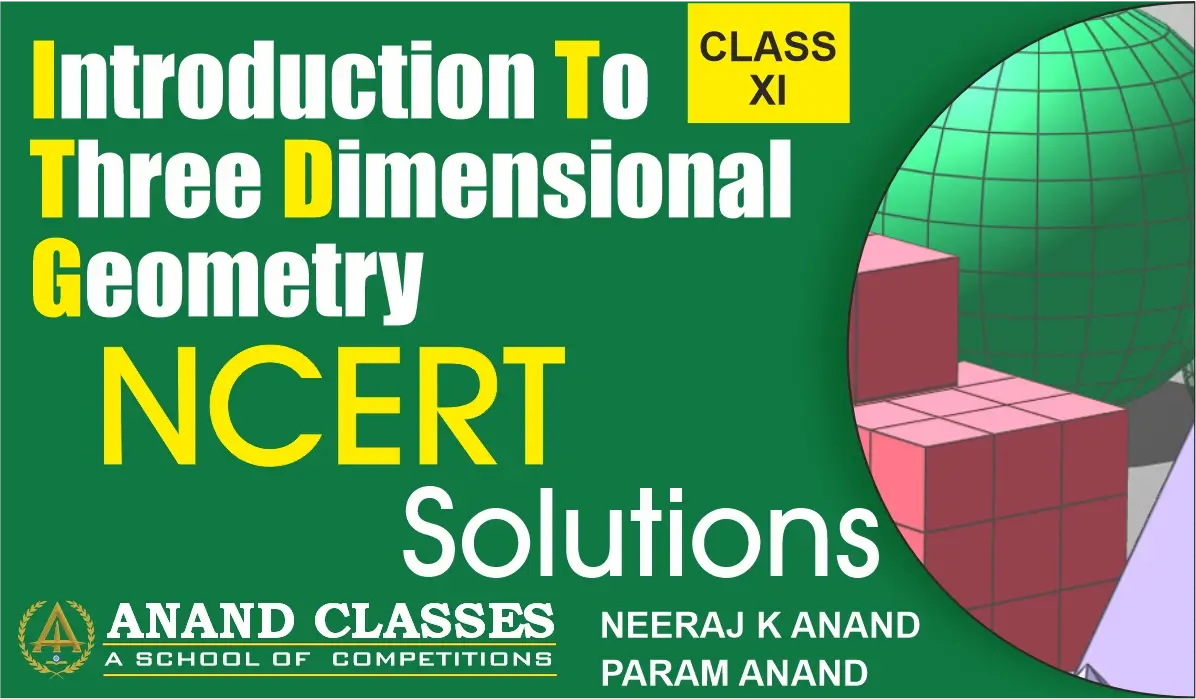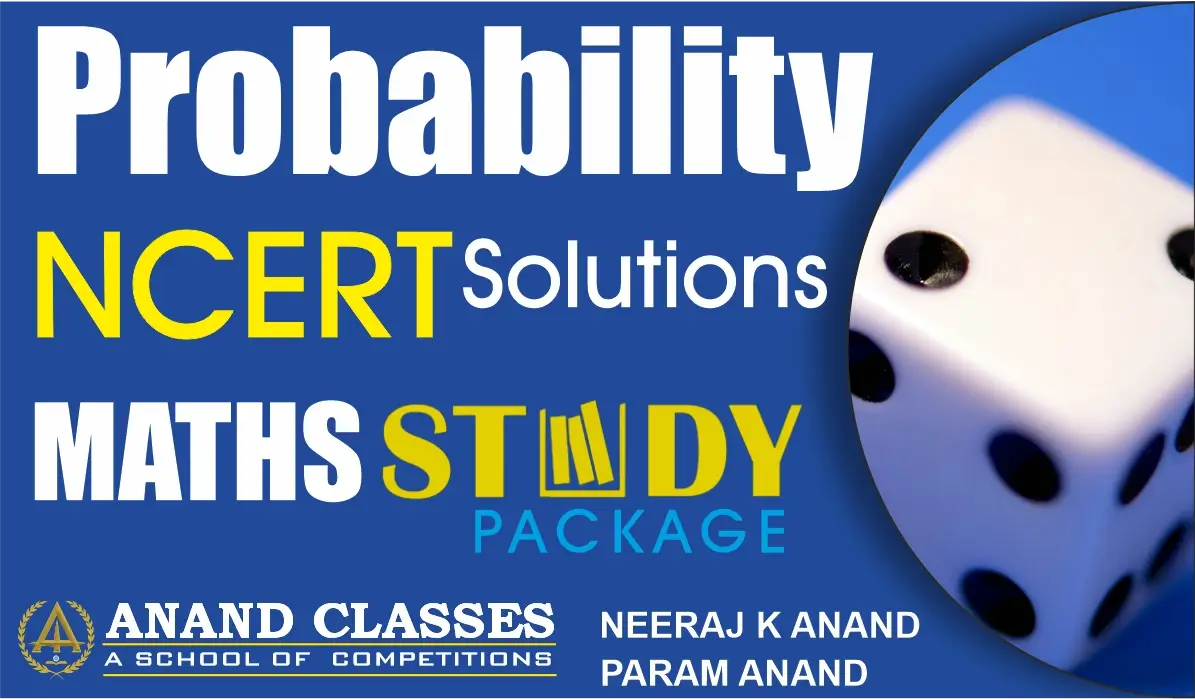Anand Classes provides complete NCERT Solutions for Class 11 Maths Chapter 6 Permutations and Combinations Miscellaneous Exercise, designed to help students practice advanced and mixed-concept problems from the chapter. These detailed, step-by-step solutions follow the latest CBSE and NCERT guidelines to ensure accuracy and conceptual understanding. Each question is solved with proper reasoning, formulas, and examples to help learners strengthen their problem-solving skills and prepare effectively for exams. Click the print button to download study material and notes.
NCERT Question 1 : How many words, with or without meaning, each of 2 vowels and 3 consonants can be formed from the letters of the word DAUGHTER?
Solution :
In the word “DAUGHTER”, there are 3 vowels, namely, A, U, E, and 5 consonants, namely, D, G, H, T, R.
Number of ways of selecting 2 vowels out of 3:
$$
{}^{3}C_{2} = \frac{3!}{2!1!} = 3
$$
Number of ways of selecting 3 consonants out of 5:
$$
{}^{5}C_{3} = \frac{5!}{3!2!} = 10
$$
Therefore, the number of combinations of 2 vowels and 3 consonants is:
$$
3 \times 10 = 30
$$
Now, each of these 30 combinations has 5 letters which can be arranged among themselves in $5!$ ways.
Therefore, the required number of different words is:
$$
30 \times 5! = 30 \times 120 = 3600
$$
Answer: Required number of words = $\boxed{3600}$
Enhance your understanding of permutation and combination problems with detailed step-by-step solutions by Anand Classes for Class 11 Maths, JEE Main, NDA, and CUET preparation.
NCERT Question 2 : How many words, with or without meaning, can be formed using all the letters of the word EQUATION at a time so that the vowels and consonants occur together?
Solution :
There are 8 different letters in the word “EQUATION”, in which there are 5 vowels, namely A, E, I, O, U, and 3 consonants, namely Q, T, N.
Since the vowels and consonants have to occur together, assume all vowels as one object $(AEIOU)$ and all consonants as another $(QTN)$. So, there are 2 objects now.
Permutations of these 2 objects taken all at a time:
$$
{}^{2}P_{2} = 2! = 2
$$
Within the vowel group, we have $5!$ possible permutations and $3!$ permutations within the consonant group.
Hence, the required number of permutations is:
$$
2! \times 5! \times 3! = 2 \times 120 \times 6 = 1440
$$
Answer: Required number of words = $\boxed{1440}$
Master word formation using permutation and combination concepts with expert NCERT Maths explanations and solved examples by Anand Classes for Class 11, JEE Main, and competitive exam preparation.
NCERT Question 3 : A committee of 7 has to be formed from 9 boys and 4 girls. In how many ways can this be done when the committee consists of:
(i) exactly 3 girls, (ii) at least 3 girls, (iii) at most 3 girls?
(i) Committee with exactly 3 girls
We have to select 7 members from a total of 13 (9 boys + 4 girls).
If there are exactly 3 girls in each combination, then
Number of ways of selecting 3 girls out of 4:
$$
{}^{4}C_{3} = \frac{4!}{3!1!} = 4
$$
Number of ways of selecting 4 boys out of 9:
$$
{}^{9}C_{4} = \frac{9!}{4!5!} = 126
$$
Hence, total number of ways to form a committee with exactly 3 girls is:
$$
{}^{4}C_{3} \times {}^{9}C_{4} = 4 \times 126 = 504
$$
Answer: $\boxed{504}$
(ii) Committee with at least 3 girls
If the team has to consist of at least 3 girls, it can have either:
- 3 girls and 4 boys, or
- 4 girls and 3 boys.
Case 1: 3 girls and 4 boys
From (i),
$$
{}^{4}C_{3} \times {}^{9}C_{4} = 4 \times 126 = 504
$$
Case 2: 4 girls and 3 boys
$$
{}^{4}C_{4} \times {}^{9}C_{3} = 1 \times 84 = 84
$$
Therefore, total number of ways to form a committee with at least 3 girls is:
$$
504 + 84 = 588
$$
Answer: $\boxed{588}$
(iii) Committee with at most 3 girls
If the team has to consist of at most 3 girls, it can have:
- 3 girls and 4 boys
- 2 girls and 5 boys
- 1 girl and 6 boys
- 0 girls and 7 boys
Case 1: 3 girls and 4 boys
$$
{}^{4}C_{3} \times {}^{9}C_{4} = 4 \times 126 = 504
$$
Case 2: 2 girls and 5 boys
$$
{}^{4}C_{2} \times {}^{9}C_{5} = \frac{4!}{2!2!} \times \frac{9!}{5!4!} = 6 \times 126 = 756
$$
Case 3: 1 girl and 6 boys
$$
{}^{4}C_{1} \times {}^{9}C_{6} = 4 \times 84 = 336
$$
Case 4: 0 girls and 7 boys
$$
{}^{9}C_{7} = \frac{9!}{7!2!} = 36
$$
Therefore, total number of ways to form a committee with at most 3 girls is:
$$
504 + 756 + 336 + 36 = 1632
$$
Answer: $\boxed{1632}$
Master the concepts of combinations and committee formation with clear, step-by-step NCERT Maths explanations by Anand Classes for Class 11 Maths, JEE Main, NDA, and CUET preparation.
NCERT Question 4 : If the different permutations of all the letters of the word EXAMINATION are listed as in a dictionary, how many words are there in this list before the first word starting with E?
Solution :
In a dictionary, words are in ascending order. Hence, for this scenario, all the words starting with A will come before the first word starting with E.
Letters of the word can be listed as the set
$$
\lbrace E, X, A, M, I, N, A, T, I, O, N \rbrace.
$$
To get the number of words starting with A, we fix the letter A at the extreme left position and then rearrange the remaining 10 letters taken all at a time.
These 10 letters include $I$ and $N$ twice each (A × × × × × × × × × ×)
Hence, the number of words starting with A is
$$
\frac{10!}{2!,2!} = \frac{3628800}{4} = 907200.
$$
Therefore, 907200 words are there in the list before the first word starting with E.
NCERT Question 5 : How many 6-digit numbers can be formed from the digits $0,1,3,5,7,9$ which are divisible by 10, and no digit is repeated?
Solution :
We know that a number is divisible by 10 if it has $0$ at its unit place. Hence, $0$ will be fixed at the last place in the number (× × × × × 0)
The remaining $5$ places can be filled by the digits $1,3,5,7,9$. These $5$ distinct digits can be arranged in $^5P_5=5!$ ways.
Hence, the number of 6-digit numbers that can be formed which are divisible by 10 (with no repetition) is
$$
5! = 120.
$$
Practice topics and related phrases: permutations with repeated letters, dictionary order of arrangements, arrangements with indistinguishable objects, factorials and permutation formulas, divisibility rules in combinatorics.
Download detailed NCERT solutions by Anand Classes for Class 11 Maths, JEE Main, NDA, and CUET preparation.
NCERT Question 6 : The English alphabet has 5 vowels and 21 consonants. How many words with two different vowels and two different consonants can be formed from the alphabet?
Solution :
We have to select 2 vowels from 5 and 2 consonants from 21.
Number of ways to select 2 vowels from 5:
$$
{}^{5}C_{2} = \frac{5!}{2!3!} = 10
$$
Number of ways to select 2 consonants from 21:
$$
{}^{21}C_{2} = \frac{21!}{2!19!} = \frac{21 \times 20}{2} = 210
$$
Now, these 4 selected letters (2 vowels + 2 consonants) can be arranged in
$$
{}^{4}P_{4} = 4! = 24 \text{ ways.}
$$
Hence, the total number of words that can be formed with 2 different vowels and 2 different consonants is:
$$
10 \times 210 \times 24 = 50400
$$
Answer: Required number of words = $\boxed{50400}$
Strengthen your understanding of permutations and combinations with vowels and consonants through detailed explanations and NCERT Maths solutions by Anand Classes for Class 11 Maths, JEE Main, NDA, and CUET exam preparation.
NCERT Question 7 : In an examination, a question paper consists of 12 questions divided into two parts i.e., Part I and Part II, containing 5 and 7 questions, respectively. A student is required to attempt 8 questions in all, selecting at least 3 from each part. In how many ways can a student select the questions?
Solution :
Since it is required to attempt at least 3 questions from each part, question selections can be taken from the set
$$
{(3,5),\ (4,4),\ (5,3)}
$$
(where an ordered pair denotes (Part I questions, Part II questions)).
Case 1: ((3,5)) — 3 from Part I and 5 from Part II
Number of ways to select 3 questions from Part I = ${}^{5}C_{3}$
Number of ways to select 5 questions from Part II = ${}^{7}C_{5}$
Total number of ways for this case:
$$
{}^{5}C_{3}\times {}^{7}C_{5} = {}^{5}C_{3},{}^{7}C_{5} = 10\times 21 = 210.
$$
Case 2: ((4,4)) — 4 from Part I and 4 from Part II
Number of ways to select 4 questions from Part I = ${}^{5}C_{4}$
Number of ways to select 4 questions from Part II = ${}^{7}C_{4}$
Total number of ways for this case:
$$
{}^{5}C_{4}\times {}^{7}C_{4} = 5\times 35 = 175.
$$
Case 3: ((5,3)) — 5 from Part I and 3 from Part II
Number of ways to select 5 questions from Part I = ${}^{5}C_{5}$
Number of ways to select 3 questions from Part II = ${}^{7}C_{3}$
Total number of ways for this case:
$$
{}^{5}C_{5}\times {}^{7}C_{3} = 1\times 35 = 35.
$$
Total number of ways for all the cases:
Adding the three cases:
$$
{}^{5}C_{3}{}^{7}C_{5} + {}^{5}C_{4}{}^{7}C_{4}+ {}^{5}C_{5}{}^{7}C_{3}
= 210 + 175 + 35 = 420.
$$
Answer: A student can select the questions in $\boxed{420}$ ways.
Download detailed NCERT solutions by Anand Classes for Class 11 Maths, JEE Main, NDA, and CUET preparation.
NCERT Question 8 : Determine the number of 5-card combinations out of a deck of 52 cards if each selection of 5 cards has exactly one king.
Solution :
We have to select 5 cards from 52 cards such that each selection has exactly one king.
Case 1: Selecting 1 king out of 4 kings
Number of ways to select king card =${}^{4}C_{1} = \frac{4!}{1!3!} = 4$
Case 2: Selecting remaining 4 cards from the other 48 cards
Number of ways to select remaining 4 cards = ${}^{48}C_{4} = \frac{48!}{4!44!} = 194580$
Hence, total number of required 5-card combinations is:
$$
{}^{4}C_{1} \times {}^{48}C_{4} = 4 \times 194580 = 778320
$$
Answer: Required number of 5-card combinations = $\boxed{778320}$
NCERT Question 9 : It is required to seat 5 men and 4 women in a row so that the women occupy the even places. How many such arrangements are possible?
Solution :
There are 5 men and 4 women. Since the women occupy the even places, the seating arrangement pattern will be:
$$
M,W,M,W,M,W,M,W,M
$$
where M denotes man and W denotes woman.
Step 1: Arrangement of 4 women
The 4 women can occupy the 4 even places in:
$$
{}^{4}P_{4} = 4! = 24 \text{ ways.}
$$
Step 2: Arrangement of 5 men
The 5 men can occupy the 5 odd places in:
$$
{}^{5}P_{5} = 5! = 120 \text{ ways.}
$$
Hence, total number of such arrangements is:
$$
{}^{5}P_{5} \times {}^{4}P_{4} = 5! \times 4! = 120 \times 24 = 2880
$$
Answer: Required number of arrangements = $\boxed{2880}$
Explore more NCERT-based examples on permutations and combinations, including problems on card selections, seating arrangements, and positional restrictions — only at Anand Classes for Class 11 Maths, JEE Main, NDA, and CUET preparation.
NCERT Question 10. From a class of 25 students, 10 are to be chosen for an excursion party. There are 3 students who decide that either all of them will join or none of them will join. In how many ways can the excursion party be chosen?
Solution:
According to those 3 students who decide to either join all of them or join none of them, there are 2 cases for excursion party member selection:
According to the given condition, there are 2 possible cases:
Case 1: None of the 3 students join
Then, the 10 students are to be chosen from the remaining $25 – 3 = 22$ students.
Hence, the number of ways to do this is
$$
{}^{22}C_{10} = 646646
$$
Case 2: All 3 students join
In this case, 3 students are already chosen, so the remaining $10 – 3 = 7$ students must be selected from the remaining $25 – 3 = 22$ students.
Hence, the number of ways to do this is
$$
{}^{22}C_{7} \times {}^{3}C_{3} = 170544
$$
Therefore, the required total number of ways to choose the excursion party is
$$
{}^{22}C_{10} + {}^{22}C_{7} \times {}^{3}C_{3} = 646646 + 170544 = 817190
$$
Hence,
$$
\boxed{\text{Required number of ways} = 817190}
$$
For more detailed NCERT Maths solutions on Combinations and Permutations, explore Anand Classes for Class 11 Maths, JEE Main, NDA, and CUET preparation.
NCERT Question 11 : In how many ways can the letters of the word ASSASSINATION be arranged so that all the S’s are together?
Solution:
The word ASSASSINATION has 13 letters, of which:
- A appears 3 times
- S appears 4 times
- I appears 2 times
- N appears 2 times
- The remaining letters (T and O) occur once each
Since all the S’s are to occur together, we take them as a single object :
$$(\text{SSSS})$$
Thus, we have the following 10 objects : $$\lbrace (\text{SSSS}), A, A, A, I, I, N, N, T, O \rbrace$$
These 10 objects can be arranged in =$\dfrac{10!}{3! , 2! , 2!}$ ways (since A, I, and N are repeated).
Now, the 4 S’s within the block $(\text{SSSS})$ can be arranged among themselves in $\dfrac{4!}{4!} = 1$ way (since all are identical).
Hence, the required number of arrangements is
$$
\dfrac{10!}{3! , 2! , 2!} \times 1
$$
Calculating,
$$
\frac{10!}{3! , 2! , 2!} = \frac{3628800}{6 \times 2 \times 2} = \frac{3628800}{24} = 151200
$$
Therefore,
$$
\boxed{\text{Required number of arrangements} = 151200}
$$
For more detailed NCERT Maths solutions and permutation-combination concepts, explore Anand Classes for Class 11 Maths, JEE Main, NDA, and CUET preparation.


